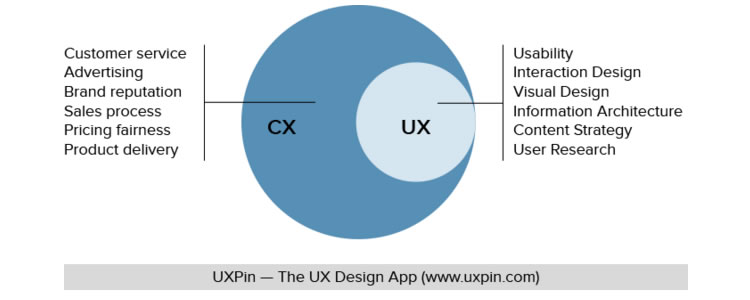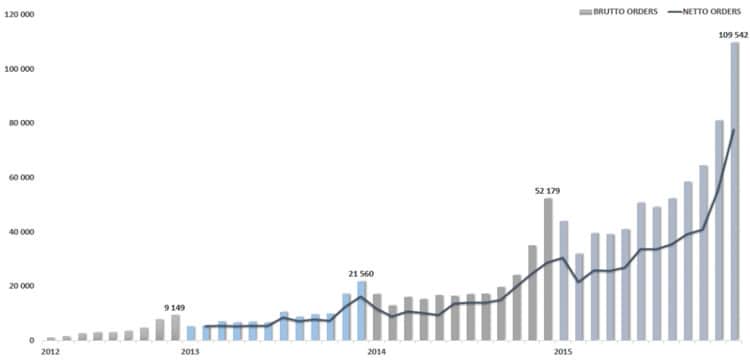
“Battle” is too strong a word. “Distraction”, may be better. I am referring to Customer Experience (CX) vs. User Experience (UX). And now that upstart, Customer Success has to come along.
To some degree I feel it is just new buzzwords vying for attention and position in Google and top consulting fees.
Ultimately it all boils down to experience.
A few years ago the image below started circulating showing UX as a list of UI design tasks plus some user research and all that being a subset of CX. I am not sure where the meme started but pretty much all UX people I know would consider the UX list to be so narrow as to be almost misinformation. As if car design was just the body and cockpit.

No. User Experience is about experience. All of it. “It is design with an awareness of every touchpoint that makes up the overall experience with your product or service” In other words, “Great experiences are the culmination of a user’s daily brand engagement.”
There is only one time I find it useful to distinguish between User and Customer. A user is an undefined entity. All customer are users, sure but so are all people just browsing or killing time, all employees, all people shopping for a service like yours, all… everyone. A customer is someone who has used your service in the way you need him/her too to make money. So the difference can be that UX is an engagement & acquisition model while CX is a retention model. Except for that specific case all I care about is delivering great experience, whatever target the group.
Every Business is an Experience Provider
You do not make cars or sandwiches or sell cleaning or banking services. You provide experiences and happen to finance the activity with sandwiches or cleaning. OK, yes, you do make stuff and provide a service but your focus should be on the experience of interacting with your company, the advertising, the products, the staff; again, everything.
A quick example: There are four wine/cheese/cold cuts/olive shops on my street within about 100 meters of each other. Their stuff is a bit on the costly side and all very similar Italian or Greek. I like them and have tried them all. Then there is one run by a couple who talk non-stop. They wave their arms, they constantly give samples of whatever they are slicing for another customer. You learn the story behind the product and how they found it (usually on some tiny island or accompanied by a dirty story). We joke, flirt, laugh with them and sometimes even with the other customer. For all I know it is all bull but whenever me and my eight year old daughter leave we:
- Have stuff we planned to buy.
- Have stuff we had never heard of but tasted – and bought.
- Spent more than we expected too – and happy about it.
- Are smiling from ear to ear and looking forward to eating our goodies and our next visit.
Again, all these shops have similar stuff and similar prices. Guess where we go the most? They provide an experience that is too much fun to skip and they finance it by peddling olives and cheese. The other shops sell stuff – maybe even better ones. I have never noticed.
I had a similar quality of experience when I first tried Jetblue about twenty years ago or when I tried First Republic Bank (if you think I am weird check out their Yelp page). It is the experience.
Experience, Organic or by Design
We experience all the time. Organic experience is ad hoc, random, the opposite of designed. A beautiful sunset on the beach. A momentary synchronicity of sounds and sights that come together just so on a city street.Interacting with a company that did not consider experience by design. It can be fantastic. It can also really suck. Usually it is completely forgettable. But mostly it is very hard to repeat.
A small business can rely on organic personality to pull off a great experience but what happens when the personality(ies) go on holiday or get sick or are not in the mood? It is fragile.
That is where the designed experience comes in. Imagine the cheese shop expanding. They now make sandwiches and serve drinks. They have a couple of small tables. And they hire a few more people. The feeling there is infectious and they hired for personality as much as skills. Their humor and enthusiasm spreads to the new staff. It all feeds back through the customers who have become part of the show as it were. The owners treat the employees well and encourage the giving of samples. Most customers are greeted by name and asked about the kids, that funny project, their lives. That is the beginning of design even if the proprietors do not know it. Fast forward a couple generations, see the shop has expanded into a chain of supermarkets but the management kept their focus on the experience and you would have something close to the Big Y stores in New England. They are a chain of huge supermarkets but when I go there in the town my parents live in I see a genuine, personal, caring interaction I am surprised is possible in such a big store.
User Experience Implementation Strategy
Before even considering the CX / UX relationship, a company needs to be ready to take experience seriously. Most businesses see themselves as makers of things or providers of some service. A company in that position will have to be ready for some serious culture change. It will need to look inward to discover what changes are necessary to become capable of consistently delivering the kind of designed experience they want.
Think of a manufacturing company that wants to expand in a big way, let us say double its output within three years. We all know almost intuitively that if they just start buying more machines and raw materials and hiring new workers they will probably fail. The first thing they need to do is to plan. That is all a strategy is, a plan.
The same applies to any big change. Shifting focus from “what we do” to “how we serve” may seem smaller and simpler than doubling output but it is very often not. Increasing output can be simply doing what they do just more so. Scaling up. The focus shift is a change of culture and that can be tough.
First off, it cannot be delegated. It needs enthusiastic buy-in from the very top. The rank and file will see it, probably correctly, as just another management buzzword and an item to check off some to-do list if they do not see the C-Levels actually doing stuff. Exactly what stuff depends on the individual situation but examples might include talking to people who recently complained or deserted your company and really listening to why they were unhappy. It might mean talking to people who have not yet chosen a provider and really listening to their concerns and expectations. It almost certainly means really, really listening to employees. For some top managers the worst news is that this needs to become a regular part of their jobs. Not for a week or a month or some transitionary period. Forever. It is no less than top leadership will expect of everyone below them. They need to lead by example. That is culture change.
Another thing to keep in mind is that you may require an employee experience strategy here. Unhappy or unmotivated employees (another subset of users) are not very likely to provide superior experience to your customers.
So now everyone spends lots of time with users gathering data. That can be dangerous. The temptation is to say, “Alice the stockbroker” or “Steve the bus driver” had this problem. Let us solve it. This does not work any better than a military strategy that gives soldiers guns and tells them to go fire off lots of bullets.
You need to plan what to do with the data to turn it into actionable information. You need to prioritize actions and expenditures. You need metrics to measure successes and yes, failures. It is true that no plan (or strategy) ever survived contact with reality. You need to be prepared to change the strategy as needed.
Developing the strategy to change the culture of a company can take time. How much time depends on individual circumstances; the size of the organization, cultural inertia that needs to be overcome and the visible determination of the leadership. It could be a couple days or it could stretch into weeks or months. In the end what do you have? A document than can fit on one or two pages.
The form might make it look bigger. Maybe ten slides in a deck, or a fifteen minute video or a year-long series of workshops. But the core principles need to be company, brand or product-specific yet brief, memorable and clear. I mention this because it can feel demotivating that after all that work and money spent on it, it is something that could have been written in an hour. The hard part was learning what to write.
Strategy Research and Development
Many people think a strategy is a top down thing. It is and it is not. It is more of a cyclic thing that should be started and, if necessary, supported from the top but it needs genuine information and some participation from all levels. One key benefit of a professionally-led Experience Strategy development effort is digging up actual data. For instance, you may want to improve the reported satisfaction of clients contacting your service reps. You can just devise something that sounds good and force it on the reps. And you might get lucky. Or you can discover what difficulties the reps face every day and what works well. And you should experiment, pilot a few ideas. You are not trying to find actual solutions – that is for tactical planning. But you are getting feedback and data to make sure your plan will be workable and specific to your situation.
In a smaller company, everyone might be close enough to each other and to the user base, that quality information is at hand. Work on elements of the strategy can begin pretty much right off. In a bigger company though there will probably need to be a phase of gathering info you already have and figuring out what questions you still need answers to. You need to learn where your real strengths are and what and where your weaknesses are.
The road-map you end up with will show a way for your company to transform into one that can design and deliver experiences. That is the bit that can take days to months. Actually working through the transformation, really changing the culture can take months to years. And though I have said it already I will say it again, without enthusiastic top level participation it is much less likely to succeed.
Experience Delivery Strategy
So far we have explored how to become an Experience Provider. Now we will look at how to develop a strategy to actually do it. And to do it again whenever you need it. This one looks outward and plans how to deliver the experience to your users. It will discuss things like touch-points, delivery platforms, user research, branding & image and service models. Unlike what is shown in the image above, we are not at all interested in UI design at this point. A key thing we will define is the primary emotion we want our users to experience.
In a company with several products or even brands, this strategy may be specific to one or some of them while others have a different strategy. Microsoft, for instance has different strategies for retail and corporate experiences.
Here we may find it useful to define differences between user experience (acquisition) strategy and customer experience (retention) strategy. Perhaps you will lure new customers by creating a sense of curiosity or encouraging inquisitiveness in your presentations and you retain them by building the feeling of belonging to the right crowd. This then informs the service design spanning your webs, apps, shops, person to person interactions and marketing.

The Czech clothing retailer Zoot does this masterfully. They deliver happiness. They have their web and print catalogue which tell stories about the people in the pictures and almost incidentally mention the clothes they have on. Delivery is free. Returns are free. They have physical shops called Happiness Pickup Points where you can get your items in several sizes to try on and of course they send a few accessories for that impulse buy.
Happiness delivery is infused throughout the company. All new employees must work for a time in every department from warehouse to marketing. They are encouraged to take days off from their regular jobs, paid days, to meet people, users. And though Zoot has an entire department devoted to making sure customers are in fact happy, everyone in the company works toward that and has lots of opportunities to make it happen. The number of people who become new customers because of a friend’s actual recommendation, not an online “like” is phenomenal enough to push the company to over 100% year on year growth since 2012. A recruiter friend told me they do not have to pay as much as the market for a job and employees typically work better than average because it is such a fun and cool company. All real life, bottom line payoffs. Oh, and their clothes are pretty cool too.

Zoot has happy employees delivering happiness to their customers and finance it by selling clothes (that make their wearers happy again every time they get worn).
Happiness is not always the best target for a business. Or not at Zoot level at least. I went to a big, chain pharmacy, Rite Aid in the US with my father a while back. There again, he was greeted by name and the health of everyone in the family was asked about. They enquired about prescriptions and refill needs in a nice, conversational way. I had noticed their loyalty programs – pretty much like everyone else’s.
But what caught my attention as a sign on the counter showing the status of a collection for one of the employee’s kids surgery (the US does not have free medical). There was a picture of a little girl in a hospital bed, a brief status report (positive), amount of money collected from customers of that specific branch and a big “Thank You”. I heard one customer add $5 for the collection on a $30 bill. The child’s mother was there and said “Thank you so much” herself, verbally, smiling and in real time. P2P, person to person, caring human being to appreciative mother. Genuine, living, human interaction achieved in seconds through a cash register. The chain made it easy – just include it on your bill and pay with your card. I have never seen that in a corporate context – real help being offered to each other. There is a community, almost a village. There are two other chain pharmacies in an identical market niche visible from the parking lot. I bet they are not much of a threat. By asking the customers to give money for a very personal cause they actually cemented their loyalty. Absolutely brilliant because it was genuine, local and gave a very deep experience.
Oh, they also have a mobile app that tracks your medicines, helps order more and serves personalised discounts but who cares. It is a nationwide US chain that feels as personal as the mom & pop pharmacy my grandfather shopped in. (Note: After writing the preceding sentence I looked up their URL to link. Here I saw their motto in Google, “With us it is personal.” Their experience design seems to have hit the mark.”)
You can bet they have a user experience strategy whatever they might call it.
Wrap-up
Having a product or service that is in the top of your class is certainly vital to business success, no question. Designing the experience you want to provide to your customers is just as important in order to position your company and earn voluntary product or brand ambassadors. As we saw, focusing on experience design, becoming an Experience Provider will maximize your customer loyalty and profitability.
Developing an Experience Strategy is key to planning and designing your experience.
Want to learn more?
Are you interested in the managerial and strategic aspects of UX? The online course on UX Management and Strategy can teach you the necessary skills on the subject and earn you an industry-recognized course certificate to advance your career. If, on the other hand, you want to brush up on the basics of UX and Usability, the online course on User Experience might be a better fit for you (or another design topic). Good luck on your learning journey!
(Lead image source: Nachrichten_muc – Creative Commons)
